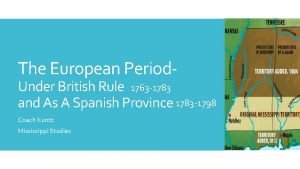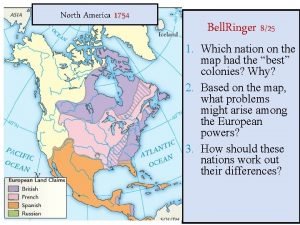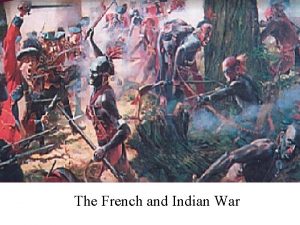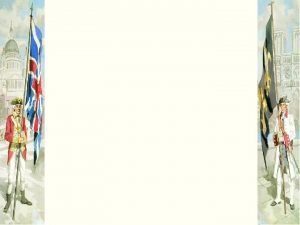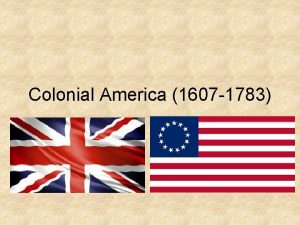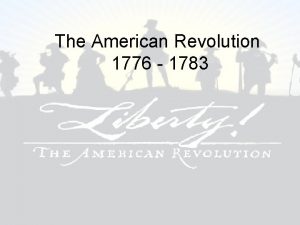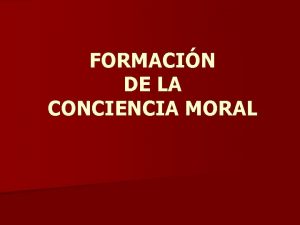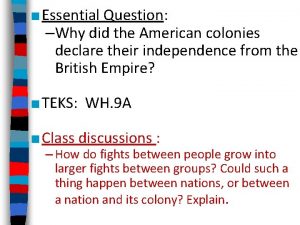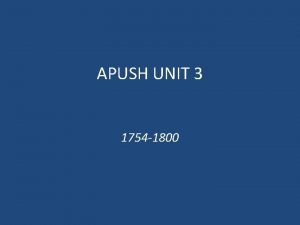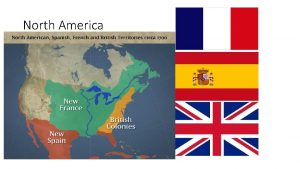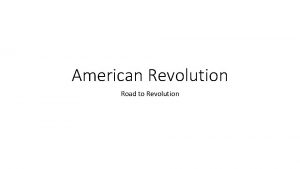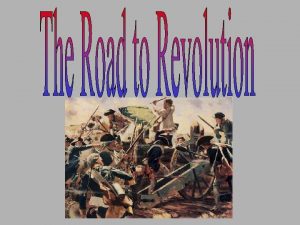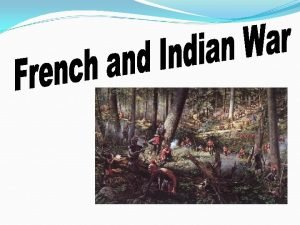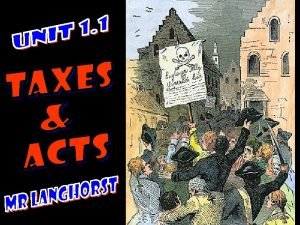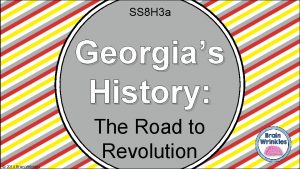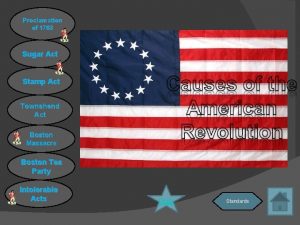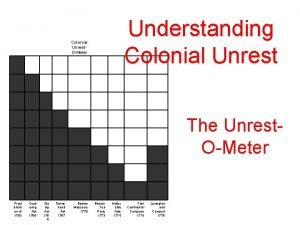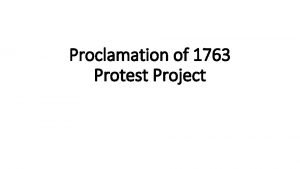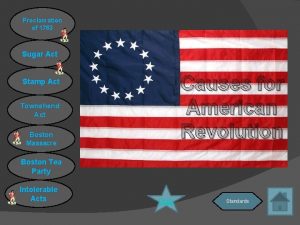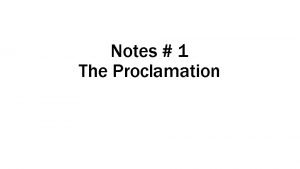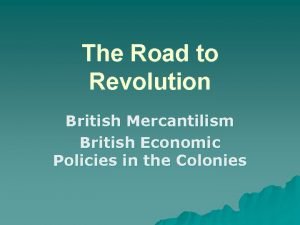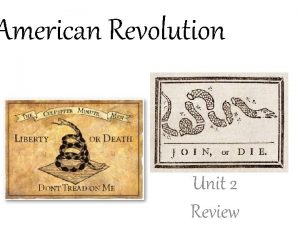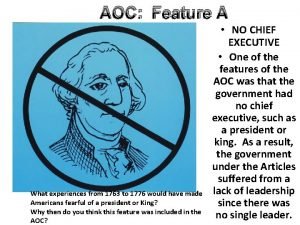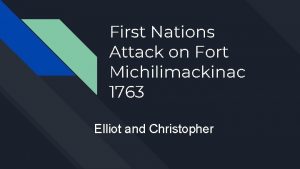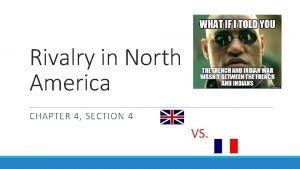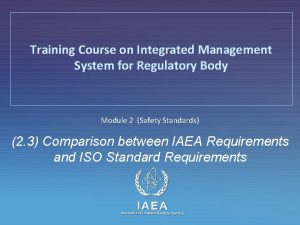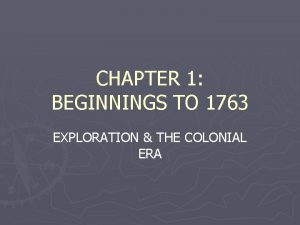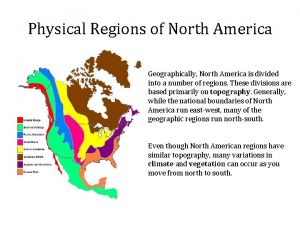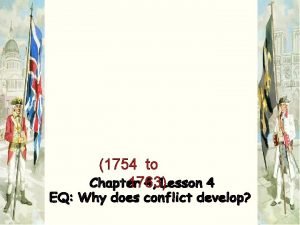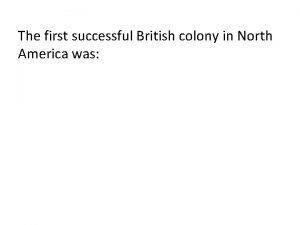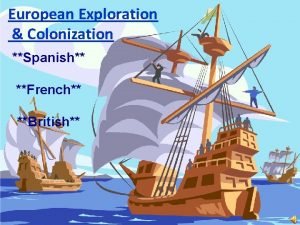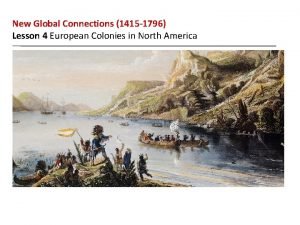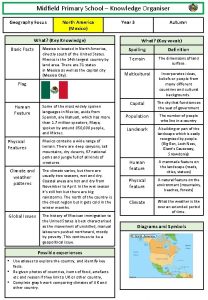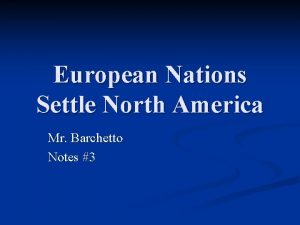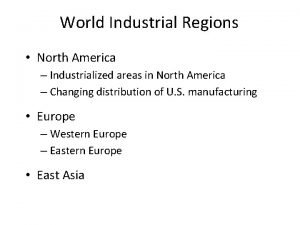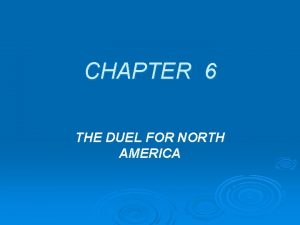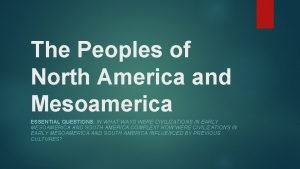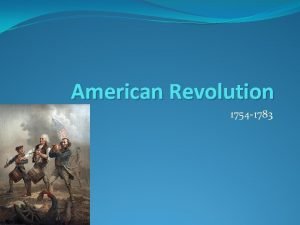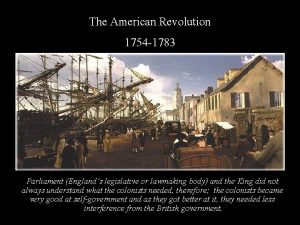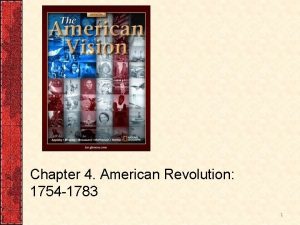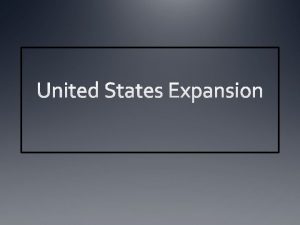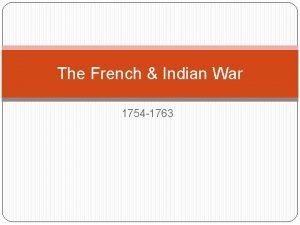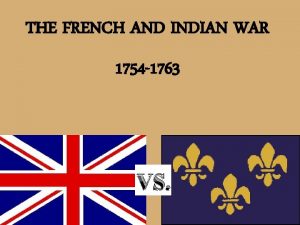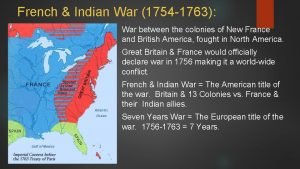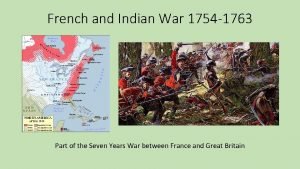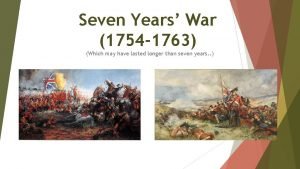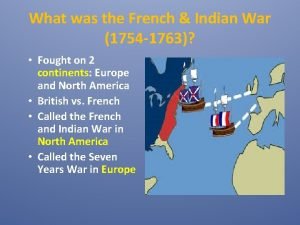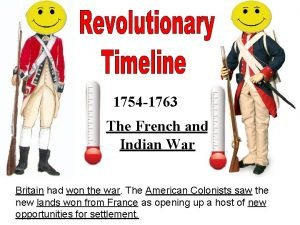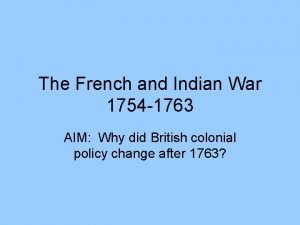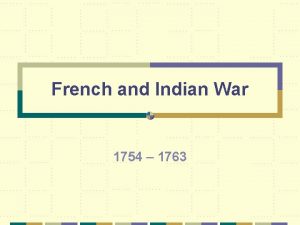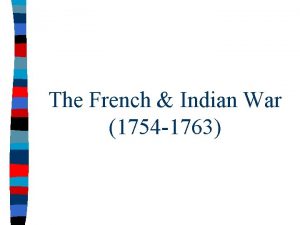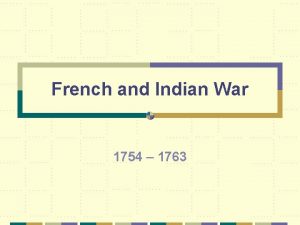North America 1763 America 1783 North America 1754






















































- Slides: 54

North America 1763 America 1783 North America 1754 North

During and after the War for Independence, each state developed their own governments A new national government was created in order to do things that states could not, like sign treaties & form a military Republic = citizens vote for elected leaders to represent them America’s 1 st national gov’t was the Articles of Confederation (1777 -1789) This “confederation” style gov’t loosely connected the states under a weak national government…we did not want a powerful government like the British

New lands gained after the war were claimed by several Westernstates Lands, 1783 The Articles established a good system of settling western lands

Land Ordinance of 1785 States give up their claims to lands in the west Government would sell lands in the west Only way the gov’t could generate money since there was no taxation

The Northwest Ordinance of 1787 Outlined rules for creating territorial governments 5, 000 people = territorial selfgoverning legislature 60, 000 residents = could apply to become a U. S. state Slavery was outlawed in the NW

Weaknesses in the Articles kept the gov’t from solving serious national problems Confederation Government in New York City

Congress had no power to lay or collect taxes Government is always short of money Congress had no power to enforce its laws (no chief executive or executive branch) The government depended on the states to enforce law. There was no effective way to coordinate the work of the government Congress was made up of one house (unicameral). One vote per state = unequal representation There was no national judicial system. There was no easy way to settle disputes between states.

Congress had no power to regulate interstate or foreign trade Economic quarrels among the states broke out often over interstate tariffs. There was difficulty in arranging for trade with other countries. The government did not have the power to maintain an army There was no national defense. States had local militias. Government was dominated by states There was no easy way to settle disputes between states. Approval of nine states was needed to enact laws. It was difficult to enact laws. Amendments to the Articles required the consent of all thirteen states. There was no practical way to change the Articles.

Shays’ Rebellion is the event that shows the Articles are not working Massachusetts passed high taxes on property which led to property foreclosures Poor farmers were angered about the taxes & threat of debtors jail Daniel Shays led an uprising and targeted debt courts MA gov’t could not pay for an army to stop the uprising After Shays’ Rebellion, political leaders in several states began calling for a stronger national gov’t

In 1787, delegates met in Instead of revising the Articles Philadelphia to discuss of Confederation, the ways to improve the delegates replaced it with the Articles Constitution

The Constitution was a radical The supremacy clause shift from the AOC because it establishes the Constitution gave more power to the (not the states) as the "the national gov’t than to the supreme law of the land" state gov’ts

Delegates at the Constitutional Convention agreed on some major philosophical ideas for the new national government

Popular Sovereignty: the people have power by voting for leaders Limited gov’t: even though the national government was stronger, citizens’ liberty was still protected Federalism: the national gov’t shares power with state gov’ts


Separation of powers: Checks & balances: each branch three branches with can limit the power of the others defined powers

The delegates at the convention had to negotiate a series of compromises in order to agree on a framework for government Many of these compromises dealt with how representatives would be chosen from the states to serve in Congress

Virginia Plan New Jersey Plan • Supported by large • Supported by small states • bicameral congress in which larger states have • unicameral congress in which states are equally more representatives represented just like the AOC

The Great Compromise created a bicameral Congress Senate = 2 House of Reps = reps who serve determined by each 6 -year terms state’s population

Northern & Southern states disagree over counting slaves toward population If slaves are counted, Southern states would have more votes and power in the House of Representatives The Three-Fifths Compromise allowed states to count three of every five slaves toward taxation and population size

B/C of the 3/5 ths Compromise, many Northerners wanted to end slavery As a compromise for the South, the slave trade could continue for 20 more years & runaway slaves would be returned to slave masters

James Madison negotiated and wrote much of the framework of the new government and is referred to as the “father of the Constitution”

Preamble Article I The Legislative Branch Article II The Executive Branch Article III The Judicial Branch Article IV Relationship Between the States and the Federal Government Article V Amending the Constitution Article VI Supreme Law of the Land Article VII Ratifying the Constitution 27 Amendments The Articles of the Constitution The Constitution is made up of 7 articles that describe the structure & powers of the national government

The Constitution needed to be approved by at least 9 states before it became the new “law of the land” Many Americans were concerned about the possibility of tyranny because the Constitution gave more power to the national government over the states

Those who opposed the Constitution, feared a stronger national gov’t , and wanted states to remain power were called Anti-Federalists The Anti-Federalists were led by Patrick Henry and Samuel Adams

Those who supported the new Constitution and a stronger national gov’t were called the Federalists Federalist leaders James Madison, Alexander Hamilton, and John Jay wrote a series of essays called the Federalist Papers to counter the arguments of the Anti -Federalists

The Bill of Rights was approved in 1791

Today, the Constitution is the oldest existing written gov’t in the world and is a model for other nations

George Washington’s Administration Washington’s years created precedents and laws that would shape the new nation

Congress passed the Judiciary Act of 1789 which created federal courts

Congress created the Treasury, State, War, Justice Departments Washington created the 1 st cabinet (group of advisors who head departments) Henry Knox, Secretary of War Alexander Hamilton, Secretary of Treasury George Washington, President Thomas Jefferson, Secretary of State Edmund Randolph, Attorney General

Alexander Hamilton was named Secretary of Treasury (Treasury Department deals with issues involving money or taxes) Hamilton and Jefferson were the most influential of Washington’s cabinet, but they had different views on the role of government Thomas Jefferson was named Secretary of State (State Department deals with issues involving foreign nations)

Alexander Hamilton believed that a strong national government was necessary to provide order in America He wanted to build a strong economy focused on industry so America could be self-sufficient He believed that the Constitution should be loosely interpreted to allow the government to respond to issues

Thomas Jefferson believed that political power should remain with state governments in order to protect liberty He wanted the economy to remain focused on farming and the gov’t to protect farmers He believed that the Constitution should be strictly interpreted with all other powers reserved to state governments

Among their biggest disagreement was over Hamilton’s Financial Plan Proposed in 1789 to guide the future of the U. S. economy 1. All state debts from the Revolution will be assumed by the federal government By taking the state debts, the USA government would force the states to work together By repaying all debts, the USA would gain foreign credit Congress and Washington approved Hamilton’s plan for funding and assumption

2. To raise money for the new nation, Hamilton proposed a tax on whiskey and a creating a protective tariff on foreign manufactured goods that would promote American industry Congress and Washington approved Hamilton’s whiskey tax But did not approve Hamilton’s protective tariff

3. Hamilton proposed creating a Bank of the U. S. (BUS) that would regulate the money supply by holding federal funds and loaning it to state banks

Jefferson argued that the BUS was unconstitutional and gave too much power to bankers in cities President Washington agreed with Hamilton and Congress passed a law creating the Bank of the U. S. in 1791 Hamilton argued that the BUS was “necessary and proper” to control the economy and regulate currency

The disagreements between Hamilton and Jefferson led to the formation of America’s first political parties Federalists supported a strong national government… …loose interpretation of the Constitution… Hamilton formed the Federalist Party …a strong financial system that favored banks and industry… …supporting England when war broke out with France

The disagreements between Hamilton and Jefferson led to the formation of America’s first political parties Republicans supported strong state governments… …strict interpretation of the Constitution… …state banks and policies that support small farmers… …supporting France when war broke out with England Jefferson formed the Democratic. Republican Party

After 4 years, George Washington was unanimously elected president for a second term In his second term (1793 -1797), Washington had to solve serious problems that faced the young nation

In 1793, war broke out between Britain and France after the French Revolution France tried to gain an American alliance in their war with Britain

Jefferson wanted the USA to support France and their fight for liberty Hamilton wanted to support Britain in order to avoid angering our largest trade partner

In 1793, Washington made an important foreign policy precedent with his Proclamation of Neutrality President Washington believed that America was too young to involve itself in a European war America politicians remained neutral in European affairs from 1793 to 1898

In 1794, Washington faced another crisis: the Whiskey Rebellion Hamilton’s whiskey tax frustrated western farmers in Pennsylvania who saw it as an unfair tax on the poor

Reminder! When Shays’ Rebellion broke out in 1787, the weak government under the Articles of Confederation could not stop the rebellion When the Whiskey Rebellion began in 1794, President Washington saw the uprising as a threat to public safety

President Washington mobilized an army of 13, 000 soldiers which ended the rebellion The quick end to the rebellion revealed the strength of the new national government under the Constitution

In 1796, Washington chose not to run for a 3 rd term as president He was afraid that if he died in office, it would create a precedent that presidents can serve for life There was no term limit in the Constitution, but Washington created the precedent that no president serve more than two terms

In 1796, George Washington gave advice to the nation in his Farewell Address Washington warned against the growth of “factions” and political parties He warned against growing sectional tensions between the North and South He restated his desire for neutrality by warning against entangling alliances

After Washington’s retirement, the Democratic. Republicans and Federalists campaigned for the presidency in 1796 Federalist John Adams defeated Republican Thomas Jefferson and won the presidency

The war between England & France was still going on and continued to cause problems for America France was frustrated Adams sent diplomats to with American neutrality France to negotiate an and began to seize agreement on American U. S. merchant ships trade rights in Europe

Three French officials (nicknamed X, Y, and Z) demanded a bribe to meet with French ministers Americans were offended by this XYZ Affair and called for war with France, but Adams kept his cool Madame Amerique

President Adams’ handling of the conflict with France led to criticisms by Democratic-Republicans Federalists in Congress passed the Alien & Sedition Acts The laws made it a crime to criticize government leaders, restricted citizenship for new immigrants, and made deporting immigrants easier This attack on free speech and citizenship backfired and badly damaged President Adams and the Federalist Party

Republicans Thomas Jefferson and James Madison wrote the Kentucky and Virginia Resolutions to attack the Federalist Party These essays presented an argument for states’ rights suggesting that states could ignore (nullify) unfair national laws These arguments of states’ rights and nullification will be used by the South to secede from the USA by 1861 and start the Civil War

Adams and his Federalist Party were unpopular by the election of 1800 Republican Jefferson defeated Adams in the election of 1800 The 1800 election marked the first time in U. S. history when one political party transferred power to another political party Jefferson’s victory over Adams marked the beginning of 30 years of dominance by the Democratic-Republican Party
 Under british rule, 1763-1783
Under british rule, 1763-1783 North america 1754 map worksheet
North america 1754 map worksheet Prewar boundaries 1754
Prewar boundaries 1754 North america 1750
North america 1750 1783-1607
1783-1607 Us in 1783
Us in 1783 Treaty of paris 1783 apush
Treaty of paris 1783 apush Catecismo de la iglesia 1783
Catecismo de la iglesia 1783 British cession date
British cession date Us in 1783
Us in 1783 Catecismo de la iglesia 1783
Catecismo de la iglesia 1783 1754 lulu love
1754 lulu love 1754 to 1800 apush
1754 to 1800 apush Countries between south america and africa
Countries between south america and africa The albany plan of union
The albany plan of union Proclamation of 1763
Proclamation of 1763 Proclamation of 1763
Proclamation of 1763 Thomas barnard sermon massachusetts 1763
Thomas barnard sermon massachusetts 1763 Ohio river valley 1763
Ohio river valley 1763 Why did the colonists hate the townshend acts
Why did the colonists hate the townshend acts Proclamation of 1763 caricatures
Proclamation of 1763 caricatures What did the proclamation of 1763 forbid
What did the proclamation of 1763 forbid Proclamation of 1763 propaganda
Proclamation of 1763 propaganda Colonial unrest-o-meter
Colonial unrest-o-meter Proclamation of 1763 protest poster
Proclamation of 1763 protest poster Proclamation of 1763
Proclamation of 1763 Proclamation line of 1763
Proclamation line of 1763 Navigation acts 1763
Navigation acts 1763 Proclamation of 1763
Proclamation of 1763 What experiences from 1763 to 1776
What experiences from 1763 to 1776 First nations attack fort michilimackinac
First nations attack fort michilimackinac True north vs magnetic north
True north vs magnetic north North east and north cumbria ics map
North east and north cumbria ics map Chapter 14 lesson 1
Chapter 14 lesson 1 The north pole ____ a latitude of 90 degrees north
The north pole ____ a latitude of 90 degrees north Define british north america act
Define british north america act Lesson 4 rivalry in north america
Lesson 4 rivalry in north america Integrated management systems training north america
Integrated management systems training north america Lesson quiz 14-2 pre-columbian america answers
Lesson quiz 14-2 pre-columbian america answers Spanish north america
Spanish north america Physical regions of north america
Physical regions of north america Lesson 4 rivalry in north america answer key
Lesson 4 rivalry in north america answer key The first successful british colony in north america
The first successful british colony in north america Fujitsu north america
Fujitsu north america North america, family histories, 1500-2000
North america, family histories, 1500-2000 Icpc north america problems
Icpc north america problems New exploration
New exploration Rising tide north america
Rising tide north america European colonies in north america
European colonies in north america North america knowledge organiser
North america knowledge organiser Spanish north america
Spanish north america Industrial regions of north america
Industrial regions of north america Chapter 6 the duel for north america
Chapter 6 the duel for north america Chapter 4 section 2 european nations settle north america
Chapter 4 section 2 european nations settle north america The peoples of north america and mesoamerica
The peoples of north america and mesoamerica
